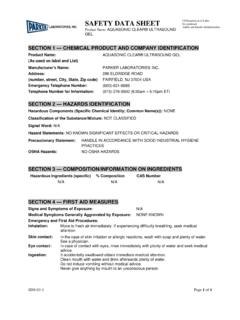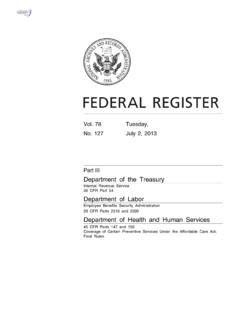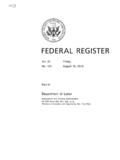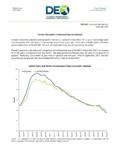Transcription of Advanced Manufacturing Competency Model - dodmrl.com
1 Employment and Training administration United States department of labor 1 Advanced Manufacturing Competency Model Updated April 2010 Updated April 2010 Advanced Manufacturing Competency Model Employment and Training administration United States department of labor 2 Table of Contents About the Model .. 3 Tier One: Personal Effectiveness Competencies .. 4 Interpersonal Skills .. 4 Integrity .. 4 Professionalism .. 4 Initiative .. 4 Dependability & Reliability.
2 4 Lifelong Learning .. 4 Tier Two: Academic Competencies .. 6 Science .. 6 Basic Computer Skills .. 6 Mathematics .. 7 Reading .. 7 Writing .. 7 Communication Listening and Speaking .. 8 Critical & Analytical Thinking .. 8 Information Literacy .. 8 Tier Three: Workplace Competencies .. 10 Business Fundamentals .. 10 Teamwork .. 10 Adaptability/Flexibility .. 11 Marketing and Customer Focus .. 11 Planning and Organizing .. 12 Problem Solving and Decision Making .. 12 Working with Tools and 13 Checking, Examining, and Recording .. 13 Sustainable Practices .. 14 Tier Four: Industry-Wide Technical Competencies .. 15 Entry-Level .. 15 Manufacturing Process Design/Development .. 15 Production .. 15 Maintenance, Installation, and Repair .. 17 Supply Chain Logistics .. 17 Quality Assurance and Continuous Improvement.
3 18 Sustainable and Green Manufacturing .. 19 Health, Safety, Security, and Environment .. 19 Technician Level .. 21 Manufacturing Process Design/Development .. 21 Production .. 21 Maintenance, Installation, and Repair .. 22 Supply Chain Logistics .. 23 Quality Assurance and Continuous Improvement .. 24 Health, Safety, Security, and Environment .. 25 Resources Reviewed .. 26 Updated April 2010 Advanced Manufacturing Competency Model Employment and Training administration United States department of labor 3 ABOUT THE Model The Advanced Manufacturing Competency Model is depicted in a pyramid graphic with nine tiers.
4 This shape illustrates how occupational and industry competencies build on a foundation of personal effectiveness, academic, and workplace competencies. Each tier is comprised of blocks representing the skills, knowledge, and abilities essential for successful performance in the Advanced Manufacturing industry. At the base of the Model , the competencies apply to a large number of industries. As a user moves up the Model , the competencies become industry and occupation specific. However, the graphic is not intended to represent a sequence of Competency attainment or suggest that certain competencies are of greater value than others. The graphic is accompanied by a table which contains definitions and associated key behaviors for each Competency block.
5 Tiers 1 through 3 contain Foundation Competencies, which form the foundation needed to be ready to enter the workplace. Tier 1 Personal Effectiveness Competencies are shown as hovering below the pyramid because they represent personal attributes or soft skills that may present some challenges to teach or assess. Essential for all life roles, personal effectiveness competencies generally are learned in the home or community and reinforced at school and in the workplace. Tier 2 Academic Competencies are critical competencies primarily learned in a school setting. They include cognitive functions and thinking styles that are likely to apply to most industries and occupations. Tier 3 Workplace Competencies represent motives and traits, as well as interpersonal and self-management styles.
6 They generally are applicable to a large number of occupations and industries. Tiers 4 and 5, called Industry Competencies, show competencies that are specific to the industry or industry sector. These cross-cutting industry-wide competencies demonstrate the viability of career lattices that allow workers to move easily across industry sub-sectors. As a result, this Model supports the development of an agile workforce that does not need to follow a single occupational career ladder. Tier 4 Industry-Wide Technical Competencies represent the knowledge and skills that are common across sectors within a broader industry. These technical competencies build on, but are more specific than, competencies represented on lower tiers. Tier 5 Industry-Sector Technical Competencies represent a sub-set of industry technical competencies that are specific to an industry sector.
7 Tiers 6 through 9 represent the specialization that occurs within specific occupations within an industry. Information on occupational competencies is available through O*NET OnLine ( ). Competency A cluster of related knowledge, skills, and abilities that affects a major part of one s job (a role or responsibility), that correlates with performance on the job, that can be measured against well-accepted standards, and that can be improved via training and development. Updated April 2010 Advanced Manufacturing Competency Model Employment and Training administration United States department of labor 4 Tier 1: Personal Effectiveness Competencies 1.
8 Interpersonal Skills: Demonstrating the ability to work effectively with others. Interact professionally and respectfully with supervisors and coworkers. Work effectively with people who have diverse personalities and backgrounds. Respect the opinions, perspectives, customs, contributions, and individual differences of others. Use appropriate strategies and solutions for dealing with conflicts and differences to maintain a smooth workflow. Be flexible and open-minded when dealing with a wide range of people. Listen to and consider others viewpoints. 2. Integrity: Displaying accepted social and work behaviors. Treat others with honesty, fairness, and respect. Comply with ethical standards for your field. Take responsibility for accomplishing work goals within accepted timeframes.
9 Accept responsibility for one s decisions and actions. Perform quality work. 3. Professionalism: Maintaining a socially acceptable demeanor. Demonstrate self-control by maintaining composure and dealing calmly with stressful situations. Accept criticism and attempt to learn from mistakes. Demonstrate a positive attitude towards work. Follow rules and standards of dress. Follow rules and standards of personal hygiene. Refrain from substance abuse. 4. Initiative: Demonstrating a willingness to work. Take initiative in seeking out new responsibilities and work challenges. Pursue work with energy, drive, and effort to accomplish tasks. Persist at a task until completion, despite interruptions, obstacles, or setbacks. Establish and maintain personally challenging, but realistic work goals.
10 Strive to exceed standards and expectations. 5. Dependability & Reliability: Displaying responsible behaviors at work. Behave consistently, predictably, and reliably. Fulfill obligations, complete assignments, and meet deadlines. Follow written and verbal directions. Comply with organizational rules, policies, and procedures. 6. Lifelong Learning: Displaying a willingness to learn and apply new knowledge and skills. Demonstrate an interest in personal and professional lifelong learning and development. Updated April 2010 Advanced Manufacturing Competency Model Employment and Training administration United States department of labor 5 Treat unexpected circumstances as opportunities to learn and adopt new techniques.







